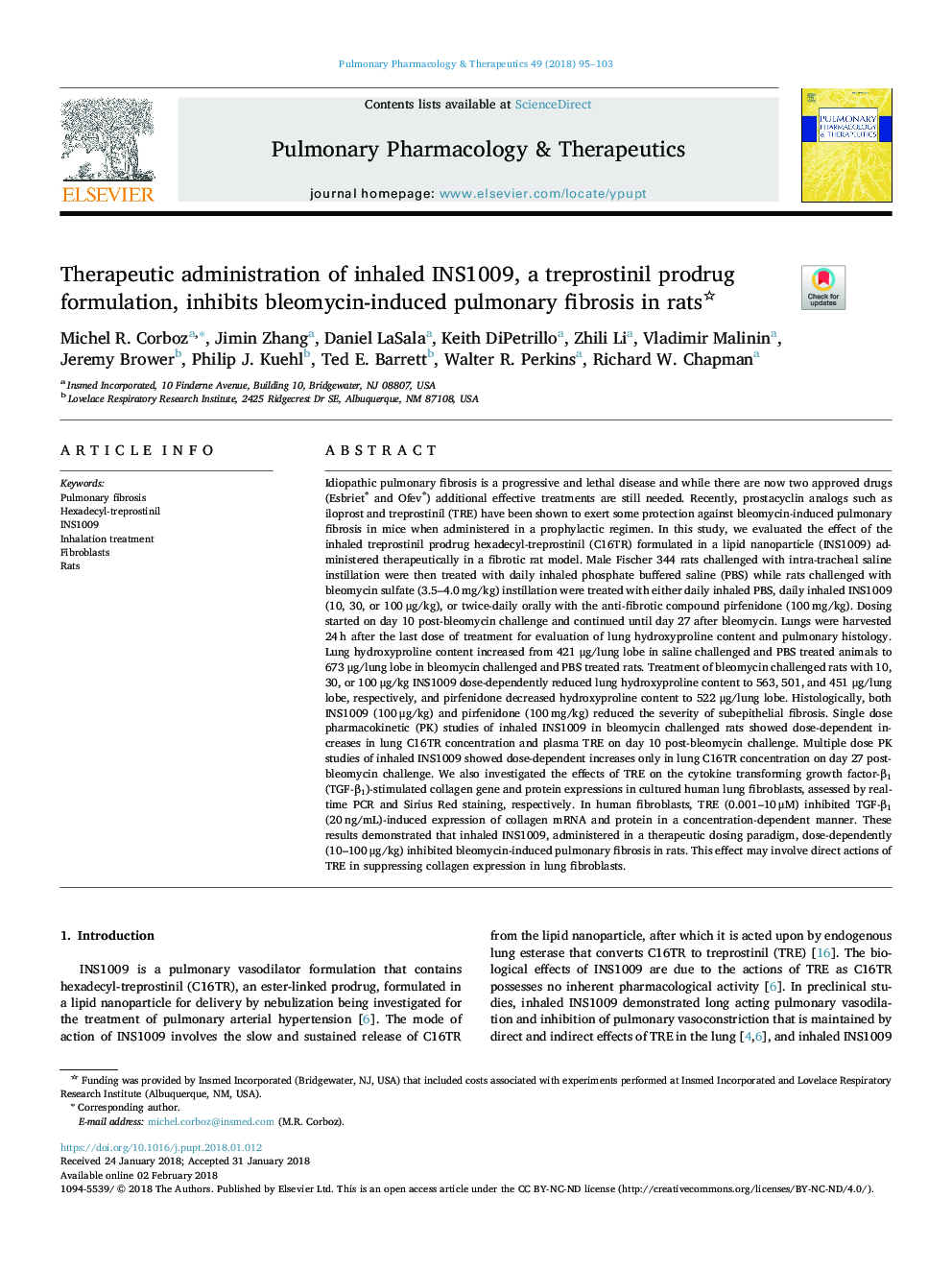| Article ID | Journal | Published Year | Pages | File Type |
|---|---|---|---|---|
| 8537797 | Pulmonary Pharmacology & Therapeutics | 2018 | 9 Pages |
Abstract
Idiopathic pulmonary fibrosis is a progressive and lethal disease and while there are now two approved drugs (Esbriet® and Ofev®) additional effective treatments are still needed. Recently, prostacyclin analogs such as iloprost and treprostinil (TRE) have been shown to exert some protection against bleomycin-induced pulmonary fibrosis in mice when administered in a prophylactic regimen. In this study, we evaluated the effect of the inhaled treprostinil prodrug hexadecyl-treprostinil (C16TR) formulated in a lipid nanoparticle (INS1009) administered therapeutically in a fibrotic rat model. Male Fischer 344 rats challenged with intra-tracheal saline instillation were then treated with daily inhaled phosphate buffered saline (PBS) while rats challenged with bleomycin sulfate (3.5-4.0â¯mg/kg) instillation were treated with either daily inhaled PBS, daily inhaled INS1009 (10, 30, or 100â¯Î¼g/kg), or twice-daily orally with the anti-fibrotic compound pirfenidone (100â¯mg/kg). Dosing started on day 10 post-bleomycin challenge and continued until day 27 after bleomycin. Lungs were harvested 24â¯h after the last dose of treatment for evaluation of lung hydroxyproline content and pulmonary histology. Lung hydroxyproline content increased from 421 μg/lung lobe in saline challenged and PBS treated animals to 673 μg/lung lobe in bleomycin challenged and PBS treated rats. Treatment of bleomycin challenged rats with 10, 30, or 100â¯Î¼g/kg INS1009 dose-dependently reduced lung hydroxyproline content to 563, 501, and 451 μg/lung lobe, respectively, and pirfenidone decreased hydroxyproline content to 522 μg/lung lobe. Histologically, both INS1009 (100â¯Î¼g/kg) and pirfenidone (100â¯mg/kg) reduced the severity of subepithelial fibrosis. Single dose pharmacokinetic (PK) studies of inhaled INS1009 in bleomycin challenged rats showed dose-dependent increases in lung C16TR concentration and plasma TRE on day 10 post-bleomycin challenge. Multiple dose PK studies of inhaled INS1009 showed dose-dependent increases only in lung C16TR concentration on day 27 post-bleomycin challenge. We also investigated the effects of TRE on the cytokine transforming growth factor-β1 (TGF-β1)-stimulated collagen gene and protein expressions in cultured human lung fibroblasts, assessed by real-time PCR and Sirius Red staining, respectively. In human fibroblasts, TRE (0.001-10â¯Î¼M) inhibited TGF-β1 (20â¯ng/mL)-induced expression of collagen mRNA and protein in a concentration-dependent manner. These results demonstrated that inhaled INS1009, administered in a therapeutic dosing paradigm, dose-dependently (10-100â¯Î¼g/kg) inhibited bleomycin-induced pulmonary fibrosis in rats. This effect may involve direct actions of TRE in suppressing collagen expression in lung fibroblasts.
Keywords
Related Topics
Health Sciences
Medicine and Dentistry
Pulmonary and Respiratory Medicine
Authors
Michel R. Corboz, Jimin Zhang, Daniel LaSala, Keith DiPetrillo, Zhili Li, Vladimir Malinin, Jeremy Brower, Philip J. Kuehl, Ted E. Barrett, Walter R. Perkins, Richard W. Chapman,
